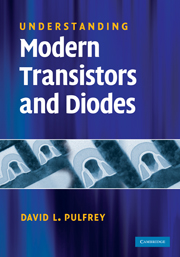Book contents
- Frontmatter
- Contents
- Preface
- 1 Introduction
- 2 Energy band basics
- 3 Electron and hole concentrations
- 4 Thermal equilibrium
- 5 Charge transport
- 6 np- and Np-junction basics
- 7 Solar cells
- 8 Light-emitting diodes
- 9 HBT basics
- 10 MOSFET basics
- 11 HJFET basics
- 12 Transistor capacitances
- 13 Transistors for high-speed logic
- 14 Transistors for high frequencies
- 15 Transistors for memories
- 16 Transistors for high power
- 17 Transistors for low noise
- 18 Transistors for the future
- Appendices
- Index
15 - Transistors for memories
Published online by Cambridge University Press: 05 June 2012
- Frontmatter
- Contents
- Preface
- 1 Introduction
- 2 Energy band basics
- 3 Electron and hole concentrations
- 4 Thermal equilibrium
- 5 Charge transport
- 6 np- and Np-junction basics
- 7 Solar cells
- 8 Light-emitting diodes
- 9 HBT basics
- 10 MOSFET basics
- 11 HJFET basics
- 12 Transistor capacitances
- 13 Transistors for high-speed logic
- 14 Transistors for high frequencies
- 15 Transistors for memories
- 16 Transistors for high power
- 17 Transistors for low noise
- 18 Transistors for the future
- Appendices
- Index
Summary
Semiconductor memory is one of the main drivers of the semiconductor industry. Competition is fierce to increase density, and to reduce power dissipation and access times. In this chapter we describe two very important and much-used types of memory cell, each based on the Si MOSFET: flash memory, and dynamic random access memory (DRAM). Both memories, and, indeed, all semiconductor memories, have the basic organizational structure shown in Fig. 15.1a. The feature of flash memory and DRAM that gives them their capability of exceptionally high density is the use of a single transistor for the memory element (see Fig. 15.1b).
Flash memory is used in computer BIOS, and has also enabled many popular products, e.g., memory sticks, digital cameras, and personal digital assistants. There is some interesting physics in this non-volatile memory element: data is stored as charge on a floating gate within the insulator of a MOSFET. Charging and discharging is achieved ‘in a flash’ via field-assisted tunnelling.
DRAM is the main memory in PCs and workstations. Data is stored in a capacitor attached to the source of a pass transistor. As we show later, the action of reading a ZERO changes the stored data, so the memory has to be refreshed periodically, hence the appellation ‘dynamic’. Leakage of charge from the storage capacitor also dictates that there be frequent refreshing of the memory's contents.
- Type
- Chapter
- Information
- Understanding Modern Transistors and Diodes , pp. 273 - 280Publisher: Cambridge University PressPrint publication year: 2010



